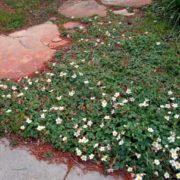Fall is the perfect time to yank those thirsty lawns and install drought-tolerant landscapes with the help of cooler days and major financial incentives.
Homeowners and businesses in San Diego County can receive between $2 and $4 per square foot for removing grass and replacing it with low water-use plants that are better suited to withstand the hot and dry conditions that continue to hammer the West.
All customers are eligible for the base rebate of $2 per square foot, but other agencies offer additional funding, including the City of San Diego and the County of San Diego.
Rebates to remove lawns available; tax incentives
In addition, a newly signed state law exempts local rebates for grass replacement from state income tax, ensuring more dollars can be spent creating beautiful and functional WaterSmart yards.
“Drought conditions make it imperative to boost water conservation in San Diego County and across the state,” said Sandra L. Kerl, general manager of the San Diego County Water Authority. “Using California tax incentives and regional rebates to install WaterSmart landscapes is a clear winner for stretching water supplies both today and for generations to come.”
Low water-use plants
California is entering a fourth straight year of drought, which climatologists say is one of the worst in state history. To make matters worse, a 22-year “megadrought” has impacted the Colorado River, which is the state’s other key source of California water supply. The impacts of a hotter, drier climate make replacing turfgrass with low water-use plants a key part of conserving our most precious natural resource.
For the past 30 years, the Water Authority and its member agencies have promoted water-use efficiency through a variety of tools such as rebates, classes, and other resources available across their service areas. Overall per capita water use in the county is down more than 40% since 1990, and the vast majority of county residents believe that water-use efficiency is a civic duty.
Landscaping upgrades are particularly important because more than half of all residential water use is outdoors. Rebates and incentives available to residents and businesses in San Diego County are at: www.sdcwa.org/your-water/conservation/.
(Editor’s Note: The San Diego County Water Authority sustains a $240 billion regional economy and the quality of life for 3.3 million residents through a multi-decade water supply diversification plan, major infrastructure investments and forward-thinking policies that promote fiscal and environmental responsibility. A public agency created in 1944, the Water Authority delivers wholesale water supplies to 24 retail water providers, including cities, special districts and a military base.)



